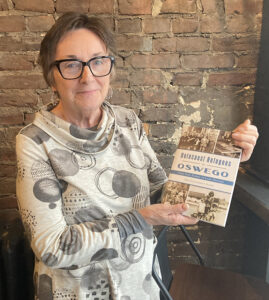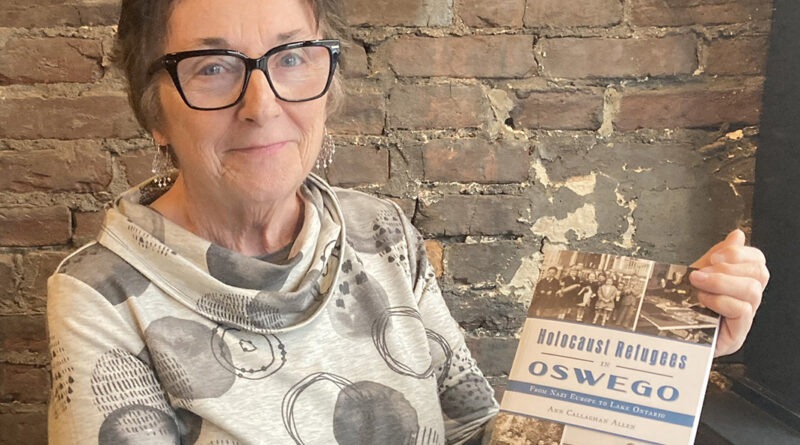Looking at the Holocaust Refugees Through Oswegonians’ Eyes
Oswego author launches ‘Holocaust Refugees in Oswego’
By Stefan Yablonski
 There has been a lot written about the 982 refugees who fled the Nazi Holocaust and their stories when they arrived in Oswego.
There has been a lot written about the 982 refugees who fled the Nazi Holocaust and their stories when they arrived in Oswego.
Ann Callaghan Allen’s new book takes a different approach. It tells the story of Oswegonians who welcomed the refugees and helped them.
“Holocaust Refugees in Oswego” has been published by the History Press and it was released March 18. It can be ordered now on Amazon or local bookstores.
“I started it a year ago January. I never intended to write a book,” she said. “I delivered the final manuscript to The History Press at the end of September — before the Israel-Hamas war broke out.”
Her editor said, “Wow this is pretty salient, for terrible reasons obviously with the rise of anti-Semitism.”
“I was looking at this in terms of more in respect to all the issues with the refuges pouring into the country at the southern border,” Allen said.
In 2018, Allen had just retired from teaching at LeMoyne (in the department of communications and film studies) and was bored. So she started writing a book about a historical Oswego woman.
It was “a great project to keep me busy and out of trouble,” she quipped. “Now it’s like, I need another project.”
“I never thought about writing about the Fort Ontario Emergency Refuge Shelter because so much had been written about it,” she continued.
However, what she discovered was a lot was written about the refuges — “but what about all these people in Oswego who interacted with them, what was that like?”
“So at the time — late December 2022, early 2023 — my husband, John, was serving on the Safe Haven Museum board. He said there are so many people who don’t know about this [place] in Oswego. He wanted to get more people interested in coming and visiting the museum.
“He said, ‘Why don’t more people from Oswego come?’ Maybe we should talk with the people in Oswego who interacted with these people, I replied. ‘Yeah, that is a good idea,’ he said.”
So Allen talked to some people who are in their 90s, “who were wonderful,” she said.
“They were all as sharp as could be and told me about what life was like back then.”
What was really key was in 1994, they did a lot of video interviews with the refuges and Oswegonians; they are all available online through Special Collections at SUNY Oswego, she added. The video interviews were very helpful, too.
When she had the discussion with her husband, writing another book wasn’t on her radar.
“I just said to him ‘I bet there are a lot of stories out there that have not been told,’” she said. “Then about two weeks later, there was a Facebook post from this guy named Ron Spereno whose father, Joe, owned Spereno’s tailor shop. I knew about it, I knew the name. And he said his father was trained by one of the refuges at the fort in the tailoring business and when the refuge’s family left for California, his father took over the business. So I said to John, ‘see I told you.’”
Then she set out to learn more. The refuge’s name was Jacob Fajnzylberg.
She searched online. His story came up in a newspaper in the mid-1950s.
“There was a great story about him,” she said. “He was a tailor in Paris before the war. He ended up in the French army, was at the battle of Dunkirk, was captured by the Germans, on a train to certain death in a concentration camp, jumps out the window of the train, makes his way back to Paris, meets up with his wife and young son there. Then joins the resistance and they make their way to Italy and are accepted to come to Fort Ontario.
“So I read all this and I’m kind of like (wow). I wondered what Joe Spereno was doing at that time? Here’s this guy (Fajnzylberg) who never would have been in Oswego, New York, but they meet because of World War II and this young man in Oswego benefits from this.”
She tracked down Ron Spereno and asked him about his father.
“We had a wonderful conversation. He told me all about his dad who was actually in high school at the time this Jacob Fajnzylberg was trying to escape the Nazis. He graduated and ended up in the Army Air Corps,” she said. “Here are two people — they are separated by everything — geography, language, culture, religion — and except for the extraordinary circumstances of World War II, their paths never would have crossed. And where do their paths cross? Oswego, New York!
“So I said to my husband, ‘look at this. This is a great story. I bet there are more like this.’ And that is what started me on writing another book.”
Long-time Oswego resident Frances Enwright visited Allen to discuss her interaction with the refugees. That meeting led Allen to talk to others, including Chris Gagas, the former CEO of Pathfinder Bank. His father owned a restaurant at the time called the Home Dairy Cafeteria; that is where the refuges congregated when they were able to leave the fort and come downtown, she said.
“I wanted to tell the story of paths crossing, where did people come from, what was their experience and what was going on with the people in Oswego,” she explained. “I didn’t tell everybody’s story — but I was able to tell a lot of stories. “I’m not a historian, immigration policy expert, not any of that. I just like to tell stories.”
Her editor told her “this is history for a general audience. What we like to do is tell stories about historic events about people and sort of whet their appetites get them interested in it — they learn about it then they want to read more.”
The fence
When the refugees first arrived in Oswego, they were disturbed to find the fort surrounded by a fence. In some ways, the fort resembled the detention camps used by the government for German prisoners of war on US soil.
“Almost everyone who has written about the refugees has talked about ‘the fence,’ made it a symbol of continuing separation, persecution and all that,” Allen said. “That bothered me so much.
“The fence has been there for decades. It was a military installation. Fran (Enwright) lived on East Ninth Street. She told me, ‘You know that fence was there for years. It was there before I was born. The military when they did training there they were using live ammunition. They needed to make sure that nobody came onto the fort grounds.’”
The refugees came in [to the fort] by railroad and that’s where the fence started.
Ralph Shapiro (Mayor of Oswego from 1960 to 1967) spoke Yiddish. He got on the train and spoke Yiddish and asked for a couple volunteers to come with him into the fort so that they could see how the barracks had been transformed and how families were going to have their own spaces. A couple people went in with him. They came back and said to everybody, ‘It’s OK, let’s go.’ And then they found out that there was a community that was welcoming.”
“Even though I didn’t experience this, these are the people who were the parents of my friends,” she added. “If you are from Oswego, there are a lot of names and places that will be instantly recognizable.”

